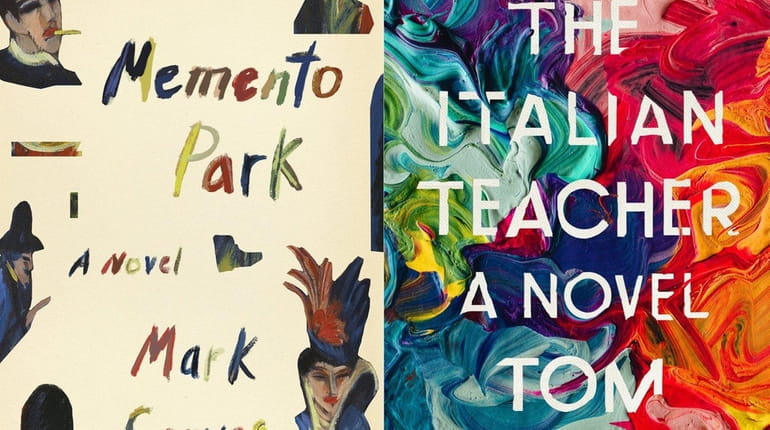Bookshelf reviews: ‘The Italian Teacher’ by Tom Rachman, ‘Memento Park’ by Mark Sarvas

New novels by Mark Sarvas and Tom Rachman examine the power of art. Credit: FSG / Viking
At the beginning of Mark Sarvas’ “Memento Park” (Farrar, Straus and Giroux, 276 pp., $26), one of two new novels about art and artists, Matt Santos, the book’s protagonist, examines a painting in an auction house and realizes “it’s possible to spend an entire lifetime looking at something, and even then, to fail to behold it in any meaningful way.”
That’s true not only of works of oil on canvas but also of much else in life. The books under review here are radically different in tone, yet they share that insight, as well as fresh variations on a familiar theme: relationships between difficult fathers and subjugated sons.
Matt is a 30-something character actor, a recognizable face whose “IMDb listing is littered with roles like ‘Second Engineer’ and ‘Reporter #3’.” He’s engaged to a swimsuit model named Tracy, “every Jewish boy’s shiksa fantasy writ large.”
While he and Tracy decorate their Christmas tree, Matt gets a call from the Australian consulate about that painting in the auction house. It’s “Budapest Street Scene,” painted in 1925 by Ervin Kálmán, a Jewish artist who killed himself “just hours ahead of the Nazis’ arrival in Budapest” in 1944.
The authorities tell Matt the painting was stolen from his father’s family in Budapest during World War II, and that Matt may be entitled to it. This news forces Matt to contact his long-estranged father, Gabor, a man whose approach down the hallway in his youth Matt says “could make the hair rise on my neck.”
Gabor doesn’t want the painting — a surprising decision for an opportunistic man. His reasons are part of the mystery of this book, a dense narrative involving Matt’s secular upbringing; Tracy’s interest in the case of a Texas death row inmate; and restitution lawyer Rachel Steinberg, a religious woman whose piety forces Matt to question whether his temporal life is bereft of meaning.
Matt’s spiritual awakening doesn’t feel earned, but “Memento Park” is still a psychologically rich portrait of familial discord. Sarvas astutely observes that many people are like actors: They convince themselves of fictions, say their lines and hide behind a character. That may be wise for actors, but it can be folly in real life. As Rachel tells Matt, “Do not make the mistake of assuming that because you know what someone will do, that you know who they are.”
Speaking of hair-raising fathers, imagine what it must have been like for Charles “Pinch” Bavinsky, protagonist of Tom Rachman’s “The Italian Teacher” (Viking, 341 pp., $27), to grow up with Bear Bavinsky for a dad. A significant artist but not a superstar, Bear is a mostly absent parent who fathers 17 children and abandons spouses with as much regularity as he sets fire to paintings — he specializes in close-ups of bare throats, rolls of tummy fat and other body parts — that displease him. His justification, “Destruction is a relief as completion can never be,” applies as much to his art as to his families.
Pinch, born in 1950, grows up in Rome, the only child of Bear’s marriage to Natalie, a failed ceramist. Pinch’s dreams of becoming an artist are crushed when Bear, remarried yet again and living in New York, offers a brutal verdict on one of teenage Pinch’s paintings: “I got to tell you, kiddo. You’re not an artist. And you never will be.”
As the decades pass, Pinch can’t quite escape his father’s assessment. After a failed art history career, he becomes an Italian instructor at a London language school. Yet he is the one child who remains close to Bear, so much so that he becomes caretaker of unsold Bavinskys at the family’s cottage in France and entertains writing his father’s biography. But Pinch discovers it’s not so easy to emerge from the shadow of a domineering charmer.
Rachman sometimes relies on caricatures, as in the case of Pinch’s college classmate Marsden McClintock, a Gitane-smoking aesthete straight out of Gilbert and Sullivan’s “Patience.” And some plot developments don’t emerge naturally from the narrative but feel engineered to drive home Rachman’s points.
But the novel takes satisfyingly unexpected turns, especially when the reader might expect a clichéd depiction of father-son strife. And Rachman offers a nuanced portrait of talented people whose lives don’t work out the way they had hoped.
“Nobody sees themselves,” Bear says to Pinch, echoing Matt’s observation at the auction house. Maybe not, but the protagonists of both books eventually learn a valuable lesson: In art as in life, if one wants to find meaning, the first step is to look.
